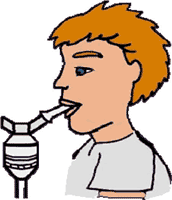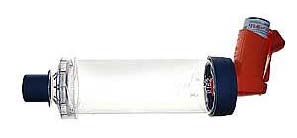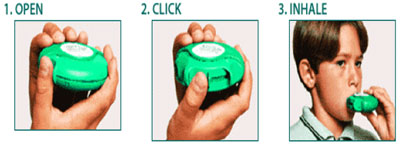Frequently Asked Questions
What is asthma?
Asthma is a chronic lung disease that cannot be cured. It can be controlled by taking medicine and making changes in your environment.
People with asthma have very sensitive airways that react to many things, such as cigarette smoke, allergies, infections, or cold air. Asthma episodes may come and go, but the lungs stay sensitive to the things that trigger asthma.
Poor control of asthma may lead to frequent emergency room visits or hospital stays. Poor asthma control can also cause death.
What causes asthma?
The basic cause of asthma is not yet known, but it tends to run in families. It may be more common in children with allergies.
Asthma Overview. Source: Children's Hospitals and Clinics of Minnesota.
What are the signs of asthma?
The main signs (symptoms) of asthma are:
- coughing
- shortness of breath
- wheezing
- tightness of the chest
- unable to sleep through the night without symptoms
- unable to exercise without symptoms
- prolonged coughing or wheezing after viral infections
Asthma Overview. Source: Children's Hospitals and Clinics of Minnesota.
What happens during an asthma episode or asthma attack?
It is important to know how the lungs work normally so you can understand what happens during an asthma episode.
When you breathe in, air goes in through the nose and mouth. It goes down your windpipe, through your airways, and into the air sacs. The air goes into your blood and is traded for the used air that you get rid of when you breathe out.
During an asthma episode a person has a hard time breathing because:
- The lining of the airways becomes swollen.
- The muscles around the airways tighten, making the airways smaller.
- Thick mucus forms, blocking small airways.

Asthma Overview. Source: Children's Hospitals and Clinics of Minnesota.
What causes asthma episodes?
Triggers such as colds, smoke, allergies, or exercise can cause an asthma episode. When triggers are present together, they have a stronger effect. Some people only have episodes when 2 or more triggers are present.
Since each person has different triggers, it is important to determine which ones affect your child's asthma so you can learn how to avoid them.
Asthma Overview. Source: Children's Hospitals and Clinics of Minnesota.
What are some early warning signs of an asthma episode?
Asthma episodes rarely come on suddenly. Often there are clues or early warning signs that an episode may occur. Some early warning signs may be runny nose, coughing, shortness of breath, not sleeping well at night, poor appetite or a decrease in peak flow.
It is important to know these signs so you can begin to treat the episodes early and prevent them from becoming severe.
Asthma Overview. Source: Children's Hospitals and Clinics of Minnesota.
How should we treat episodes?
You need to work with your child's doctor to develop an asthma action plan that helps you control asthma and treat asthma episodes. Your child should have a rescue medicine (such as albuterol) to treat an episode of coughing, wheezing, or shortness of breath.
Asthma Overview. Source: Children's Hospitals and Clinics of Minnesota.
How can we prevent episodes?
You and your child should learn all you can about asthma to help you control it. Asthma episodes may be prevented by avoiding asthma triggers and taking a controller medicine, if prescribed by your doctor. If your child's asthma action plan includes a daily controller medicine, be sure to give it every day, even when your child feels good.
Asthma Overview. Source: Children's Hospitals and Clinics of Minnesota.
How do I know if asthma is in control?
Most people with controlled asthma will be able to:
- be active, including participating in exercise and sports, without having asthma symptoms
- sleep through the night without coughing, wheezing, or feeling short of breath
By getting proper treatment and avoiding asthma triggers, most people can:
- prevent most asthma episodes
- prevent emergency visits to the doctor
- prevent hospital stays for asthma
Asthma Overview. Source: Children's Hospitals and Clinics of Minnesota.
When should I call the clinic?
Call the clinic if:
- coughing, wheezing, or shortness of breath not controlled with rescue medicine for at least 4 hours
- coughing or wheezing at night or with exercise
- in the Yellow Zone [on asthma action plan] for more than 12 to 24 hours
See the doctor right away if:
- coughing or wheezing is not better or gets worse after rescue medicine has been given
- retracting (chest or neck skin pulls in with each breath)
- peak flow* rate goes down or stays the same after rescue medicine has been given
- unable to lie down flat without trouble breathing
If you cannot reach the doctor, go to the Emergency Room.
Call 911 if:
- trouble walking or talking
- lips or fingernails are blue or gray
- stops breathing
- you are worried about how your child will get through the next 30 minutes
Asthma Overview. Source: Children's Hospitals and Clinics of Minnesota.
How to use the compressor-driven nebulizer
Assembling the Nebulizer:
- Wash your hands.
- Remove all nebulizer parts from the plastic bag, including mask/mouthpiece, flex tubing, nebulizer cup, and connecting tubing.
- Assemble the nebulizer by attaching the t-piece to the nebulizer cup, and then attaching flex tubing to one end of the t-piece and mouthpiece or mask to the other end.
- Attach connecting tubing to the outlet on the bottom of the nebulizer cup. Attach the other end to the outlet on the nebulizer compressor.
Using the Nebulizer:
- Sit upright in a comfortable chair. An infant or small child may be held upright on lap or in arms.
- Place mouthpiece in mouth or place mask on infant or child.
- Turn switch on compressor to the "on" position.
- Breathe normally through the mouthpiece or mask, taking a deep breath every minute or so. Continue until neb cup begins to sputter. Shake or tap the cup and continue breathing through the mouthpiece/mask until nearly all liquid in neb cup is gone.

Asthma Overview. Source: Children's Hospitals and Clinics of Minnesota.
How to use an inhaler with a spacer/holding chamber
- Shake the inhaler for at least 10 seconds.
- Insert inhaler into spacer (technique will vary with type of spacer; refer to manufacturer instructions).
- Tilt your head back slightly and breathe out until lungs are completely empty.
- Put the mouthpiece into your mouth between your teeth and close your lips around it. Do not block opening with your tongue.
- Press down once on the inhaler canister.
- Breathe in deeply and slowly through your mouth.
- Keep breathing in slowly, as deeply as you can.
- Hold your breath as you count slowly to 10, if you can.
- Wait at least 1 minute between puffs.

Asthma Overview. Source: Children's Hospitals and Clinics of Minnesota.
How to use your Diskus (Serevent and Advair)
- Open:
- Hold the DISKUS in left hand and place the thumb of your right hand on the thumb grip.
- Push away until the mouthpiece appears and snaps into position.
- Click:
- Hold the DISKUS in a level, horizontal position.
- Slide the lever away from you as far as it will go until it clicks. The DISKUS is now ready to use.
- Every time the lever is pushed back, a dose is made available for inhaling. The dose counter shows this. At this point do not close the device, play with the lever, or advance the lever more than once because this will release doses that will be wasted.
- Inhale:
- Before inhaling your dose of DISKUS, exhale all the way, holding the DISKUS level and away from your mouth. Remember, never breathe out into the DISKUS mouthpiece.
- Place the mouthpiece between your lips. Breathe in steadily and deeply through the DISKUS, not through your nose.
- Hold your breath for 10 seconds, and then exhale slowly.
- Close:
- To close the DISKUS, put your right thumb on the thumb grip and slide it back towards you as far as it will go. The DISKUS will click shut. The lever will automatically return to its original position and will reset. The DISKUS is now ready for your next scheduled dose.
- The dose counter will now display the number of doses remaining. When five doses are left, the number will be displayed in red.
- Finish: Rinse your mouth with water. Do not swallow.

Asthma Overview. Source: Children's Hospitals and Clinics of Minnesota.